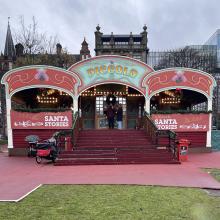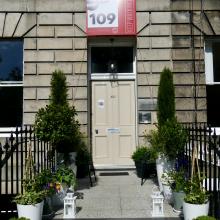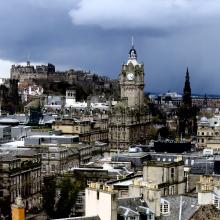
By Charlie Ellis
The possible closures of the People’s Story Museum and Summerhall Arts Centre have attracted plenty of controversy, as has the continuing uncertainty about the Filmhouse. They have added to the sense of a looming cultural crisis in a city which prides itself on its wealth of cultural institutions and events, most notably the Edinburgh Festival and Fringe.
However, visitors to the city who want to know about the history of the Festival will find very little to elucidate them. Where can they go to find out about it? The one location that could guide them is not currently properly accessible – that is the Demarco Archive, currently housed at Summerhall.
Now 94, Richard Demarco is widely recognised as one of Scotland’s most important cultural figures and something of a public intellectual. He has, perhaps uniquely, attended every Edinburgh Festival since experiencing the first one in 1947 as a 17-year-old Holy Cross Academy pupil.
Summerhall has grown to become a key venue for art and performance since it was acquired from Edinburgh University in 2011. It has aimed to keep the Festival and Fringe spirit alive all year round, not just during August. Though much praised, the building has struggled to remain afloat financially. At present, its future as an arts venue is very much in doubt. It seems quite likely that it may be turned into flats, with its cultural element reduced or even erased. Among Summerhall’s most important aspects is the vast collection of material that constitutes the Demarco Archive.
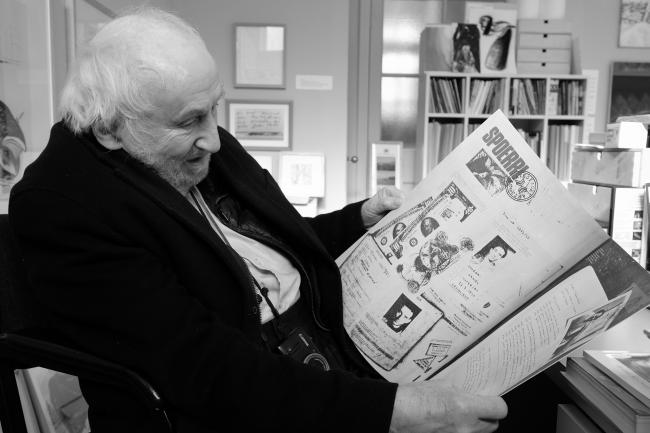
Photograph by Edward Schneider.
A rich record
The National Galleries of Scotland are planning to house a large amount of archival material collected by Demarco at their proposed The Art Works facility in Granton. However, this is the collection that the National Galleries acquired from Demarco in 1995, not the material now at Summerhall (and other material at his home and in his studio in Midlothian) which Demarco considers more significant.
The archive’s thousands of documents, artworks, posters, photographs and videos tell the tale of the Edinburgh Festival and Fringe. It is also a record of Demarco’s many connections with artists throughout Europe. The world-renowned Serbian conceptual and performance artist Marina Abramović recently spoke of the key role played by ‘the legendary’ Demarco in presenting her first international performance in 1973. She is typical of the path-breaking artists whom Demarco has promoted.
The archive is a rich record of this activity. It has only been partly catalogued, but it’s littered with gems. On a recent visit I explored one small section of it in which every box contained fascinating items, including Demarco’s delightful annotated sketches of cultural events he participated in and helped organise. Also evident were the aesthetic qualities of much of the material, including stylish posters and evocative photographs. The photographs, mainly taken by Demarco himself, capture key cultural events and also capture places in the city that have since been lost. Such material deserves to be made publicly available in a suitable location.
Photograph by Kim Traynor, Wikimedia.
The need to move
Robert McDowell, Demarco’s long-time collaborator, has made Summerhall an effective home for his archive, devoting 13 rooms to the collection. However, it has never been ideal as very little of the material can be exhibited or accessed in a proper manner. Parts that focus on particular countries are well laid out but other parts lie largely in storage boxes and large drawers.
This goes against Demarco’s hope that the archive will be ‘an educational resource’, used by ‘future generations of artists, historians, academics and students’ and an inspiration to present and future generations. He hopes that a team of archivists and historians will ‘emphasise the fact that the Demarco Archive is a living archive, protecting the unique role of Edinburgh as a world capital of culture by its internationally renowned annual Edinburgh International Festival’.
This potential is thwarted by its current location. At present, most of it sits unused and unexplored. Another serious concern is the leaks caused by rather ancient plumbing which regularly blocks and overflows. Plaster has fallen from the ceiling in several sections, including on one of the corridors in the Demarco Archive section of the building. The place needs substantial restoration.
Demarco feels he must move. ‘I have had to face the fact that we have no alternative but to end our eleven years under the life-enhancing patronage of Robert McDowell and his Summerhall Arts Centre.’ But where and how? The Demarco Archive Trust is currently examining possible new locations. It has also begun a fundraising campaign to cover the very substantial costs involved in moving and rehousing the collection.
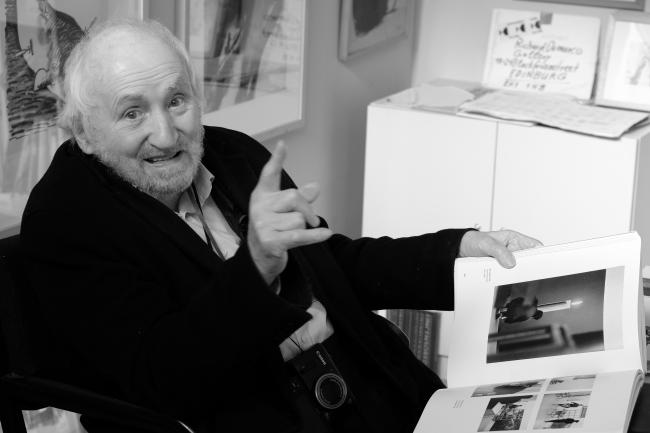
Photograph by Edward Schneider.
The prospect of light
However, even to simply store it is beyond the Demarco Archive Trust’s finances. They have launched a major appeal, with an initial target of £50,000. This is a conservative estimate of the costs involved in moving to a new permanent home in 2025, as well as reviewing the collection and professionally conserving as many artworks as possible. As part of the fund-raising campaign, a dinner is to be held at Prestonfield House on 15 November. James Thomson will host this event, which will be accompanied by an auction of artworks, many of which will come from the Demarco Art Collection.
Though Demarco’s optimism is starting to wane, his passion for art remains undiminished. He holds that ‘that which contains darkness also contains the prospect of light’. The Edinburgh Festival was created in a time of general scarcity and political turmoil. Because of this, Demarco retains a faith that art will endure through uncertain times. He believes his archive manifests this deep belief. Hence, he needs the archive to survive to illustrate the cultural values that inspired him and the Edinburgh Festival.
